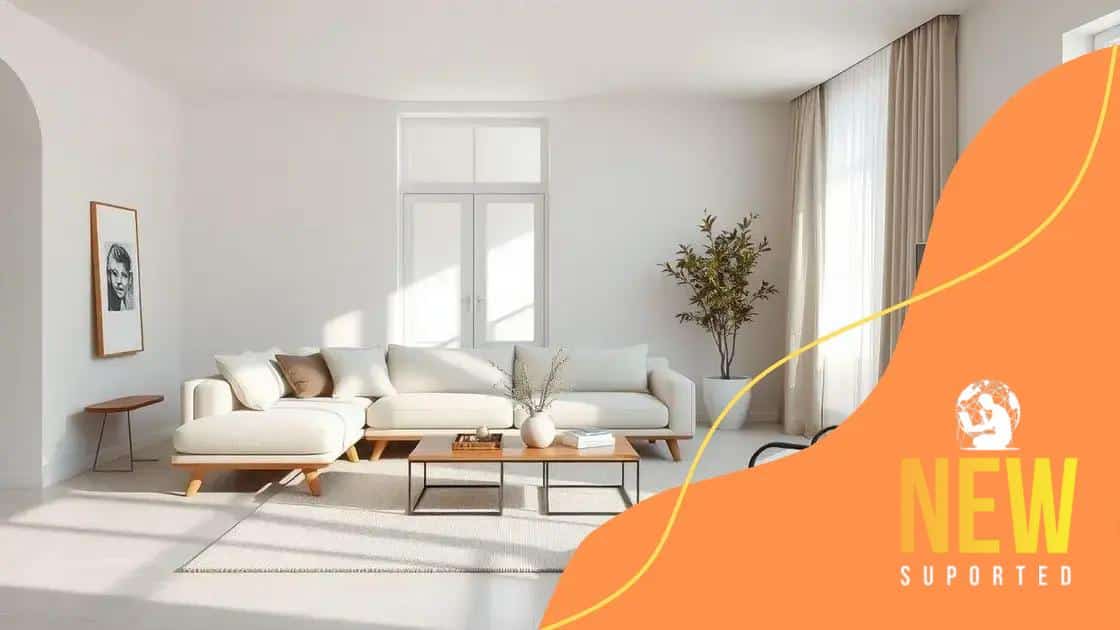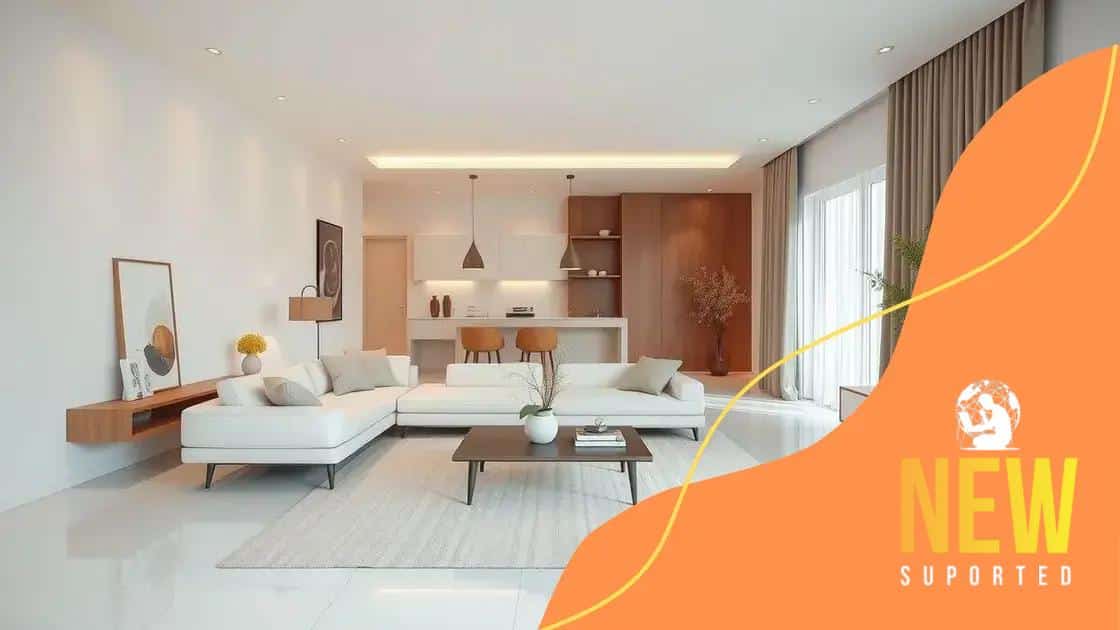The rise of minimalistic decor in modern homes

The rise of minimalistic decor in modern homes emphasizes simplicity, functionality, and intentional living, allowing individuals to enjoy serene spaces while reducing clutter and enhancing mental clarity.
The rise of minimalistic decor in modern homes is changing how we view our living spaces. Have you ever considered how a simpler environment can enhance your well-being? Let’s dive into this intriguing trend.
Understanding minimalistic decor
Understanding minimalistic decor involves recognizing how simplicity can transform spaces. This style emphasizes functionality, simplicity, and elegance. By focusing on essential elements, minimalism invites tranquility and creates an environment that’s both practical and inviting.
Key Characteristics of Minimalistic Decor
When exploring this approach, you’ll notice several defining traits. These elements work together to create a cohesive aesthetic that remains warm and welcoming.
- Neutral color palettes: Fresh whites, soft beiges, and muted grays are typical.
- Functional furniture: Each piece serves a purpose and enhances the space.
- Minimal ornamentation: Decorative items are chosen carefully to maintain a clutter-free look.
- Natural light: Spaces are designed to maximize sunlight, enhancing natural beauty.
Additionally, minimalistic decor isn’t just about aesthetics; it cultivates a sense of calm. The lack of clutter can help reduce stress and increase focus. By embracing minimalism, individuals often find inspiration and creativity flourishes more freely.
Benefits of Minimalistic Design
Beyond mere visual appeal, there are several important benefits to adopting this style. Minimalism allows you to:
- Save time on cleaning and maintenance, as fewer items require less upkeep.
- Streamline your life, promoting clarity and decision-making.
- Create a more sustainable living environment by selecting high-quality, durable items.
In the end, minimalistic decor symbolizes more than just a design choice; it represents a lifestyle shift towards simplicity, clarity, and a deeper connection to one’s personal space. As you embrace this style, consider how each element serves function and beauty, allowing your home to reflect your true self.
Key elements of minimalistic design
Key elements of minimalistic design are what set this style apart from others. Emphasizing simplicity, each component in a minimalist space serves a purpose without unnecessary complexity.
Simplicity
The first principle to understand is simplicity. This means choosing clean lines and uncluttered spaces. The goal is to create a serene atmosphere by eliminating distractions.
Functionality
Each item in a minimalistic decor must be functional. This focus ensures that every piece, from furniture to decor, has a reason for being. When space is limited, functionality becomes vital.
- Choose multi-functional furniture, like a sofa bed.
- Incorporate hidden storage solutions to reduce clutter.
- Opt for lighting that serves both aesthetics and utility.
A minimalistic space often features a carefully curated selection of items. This careful selection results in a clean and organized environment, promoting relaxation and clarity. By allowing only essential elements, minimalistic design fosters a sense of peace and order.
Neutral Color Palettes
Neutral colors play a critical role in minimalistic design. Shades of white, gray, and beige create a cohesive look that is soothing to the eye. These tones make spaces feel larger and more open.
- Paint walls in soft neutrals to maximize light.
- Use darker accents sparingly to add depth without overwhelming.
- Select furniture in light tones for a cohesive feel.
Avoiding bold colors allows the focus to shift to textures and materials instead. This approach adds interest without sacrificing the overall minimalist aesthetic.
Natural Light
Natural light is another essential component of minimalism. Large windows and open spaces can invite light into your home. This feature not only enhances the visual appeal but also promotes well-being.
Maximizing sunlight can brighten rooms and create a more inviting environment. Consider sheer window treatments that allow light while maintaining privacy.
By incorporating these key elements of minimalistic design, you can create a space that reflects clarity, tranquility, and intentional living. Keep in mind that less truly can be more when every piece is thoughtfully selected.
Benefits of a minimalist aesthetic

Benefits of a minimalist aesthetic go beyond just visual appeal. Embracing minimalism can significantly impact your lifestyle and well-being. By focusing on what truly matters, you can create a more fulfilling life.
Clarity and Focus
One of the most notable benefits is the sense of clarity it brings. With fewer distractions in your environment, you can concentrate better on tasks. This helps improve productivity and allows you to be more present in your daily life.
- Clear spaces promote clear thinking.
- Reduced clutter decreases stress and anxiety.
- Focused environments enhance creativity.
Reducing clutter not only clears your physical space but also helps declutter your mind. This can lead to a more peaceful and focused lifestyle.
Improved Well-Being
Another significant advantage of a minimalist aesthetic is the positive effect it has on your mental health. Living in a simple and organized space nurtures a sense of calm.
- Simple surroundings can lower anxiety levels.
- A minimalist home encourages relaxation and mindfulness.
- Living with less can foster gratitude and appreciation for what you have.
By creating a serene environment, minimalism becomes a tool for better mental health. This shift often leads individuals to explore deeper connections with themselves and their surroundings.
Sustainability and Finances
Minimalism also encourages a more sustainable lifestyle. By prioritizing quality over quantity, you can reduce waste and contribute to a healthy planet. Opting for timeless pieces instead of trendy items not only helps the environment but can also save you money in the long run.
Moreover, with fewer possessions to buy and maintain, you can direct your finances toward experiences rather than things. This change can lead to a more enriched life filled with meaningful moments.
In summary, the benefits of a minimalist aesthetic extend into various aspects of life, promoting clarity, well-being, and financial wisdom. By embracing minimalism, you foster a sense of joy and fulfillment that resonates throughout your daily experiences.
Tips for transitioning to minimalism
Tips for transitioning to minimalism can help you embrace this lifestyle change smoothly. Adopting a minimalist approach doesn’t happen overnight; it’s a gradual process that leads to a more intentional life.
Start with Your Space
The first step is to assess your living space. Take a good look around and identify items that no longer serve a purpose. Gradually decluttering your space creates a foundational change.
- Begin with one room at a time to avoid feeling overwhelmed.
- Sort items into categories: keep, donate, and discard.
- Use the “one in, one out” rule to manage new items.
By focusing on physical belongings, you begin to see how much excess you may accumulate. This leads to a clearer and more inviting environment.
Practice Mindful Purchasing
Next, shift your mindset towards buying things. Before making a purchase, think critically about whether it truly adds value to your life.
- Ask yourself if you need the item or if it’s simply a want.
- Consider the long-term use of the item.
- Choose quality over quantity whenever possible.
This mindfulness allows you to avoid clutter before it even enters your home. Focusing on necessity helps reinforce your commitment to minimalism.
Digital Decluttering
Don’t forget about your digital life. Just as belongings accumulate in the physical world, digital clutter can also cause stress. Take steps to tidy up your online spaces.
- Delete unnecessary apps that clutter your devices.
- Organize files into folders for easier access.
- Unsubscribe from email lists that no longer interest you.
A more streamlined digital presence supports the minimalist lifestyle as well, reducing distractions and increasing focus.
Incorporating these tips for transitioning to minimalism can help you create a simpler, more intentional life. Each small step contributes to a larger transformation that promotes serenity and clarity.
Common misconceptions about minimalism
Common misconceptions about minimalism often prevent people from fully embracing this lifestyle. Understanding these myths can help individuals appreciate the value of minimalism and how it can positively impact their lives.
Myth 1: Minimalism Means Living with Nothing
One of the biggest misconceptions is that minimalism requires you to live with as few belongings as possible. In reality, minimalism is about choosing to keep what adds value to your life.
- You can still have furniture and decor that you love.
- The focus is on quality over quantity.
- It’s about creating space for what truly matters.
Minimalism does not equate to deprivation; rather, it is about intentionality and purpose in what you own.
Myth 2: It’s Only About Aesthetics
Another misconception is that minimalism is solely about creating a clean and tidy appearance. While an uncluttered space is a benefit, the essence of minimalism lies in simplifying life choices.
This simplification allows for mental clarity and a greater focus on experiences rather than possessions. Minimalism encourages a lifestyle centered on well-being and fulfillment.
Myth 3: It’s Only for Young People
Many believe that minimalism is a trend primarily for young, urban dwellers. However, minimalism can resonate with people of all ages. It is about personal choice and aligning your lifestyle with your values, regardless of age.
Older generations often appreciate the principles of minimalism, as it aligns with decluttering spaces and simplifying lives. Minimalism is versatile and can suit anyone looking for a change.
Myth 4: Minimalism is Inflexible
Some people see minimalism as strict and limiting, viewing it as a rigid set of rules. In truth, minimalism is highly personal and can be adapted to fit individual needs.
- You can define what minimalism means for you.
- It can evolve over time as your life changes.
- There is no one-size-fits-all approach to minimalism.
This flexibility allows for a minimalist lifestyle that is both practical and enjoyable, fitting your unique preferences and circumstances.
By addressing these common misconceptions about minimalism, individuals can approach this lifestyle with a clearer understanding and greater openness to its benefits.
FAQ – Common Questions About Minimalism
What is minimalism?
Minimalism is a lifestyle choice that focuses on simplicity and intentional living, by reducing clutter and emphasizing quality over quantity.
Do I have to get rid of all my belongings to be a minimalist?
No, minimalism is not about living with nothing; it’s about keeping only what adds value to your life.
Can minimalism improve my mental well-being?
Yes, reducing clutter and distractions can lead to a clearer mind, reduced stress, and increased focus.
Is minimalism suitable for everyone?
Absolutely! Minimalism can be tailored to fit any lifestyle, regardless of age or personal circumstances.






